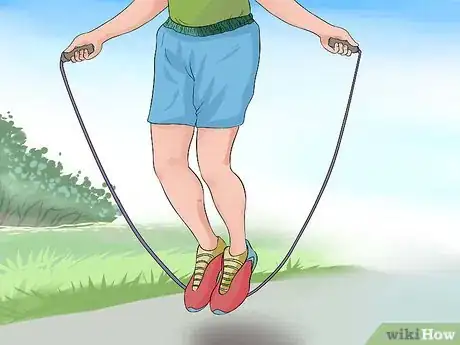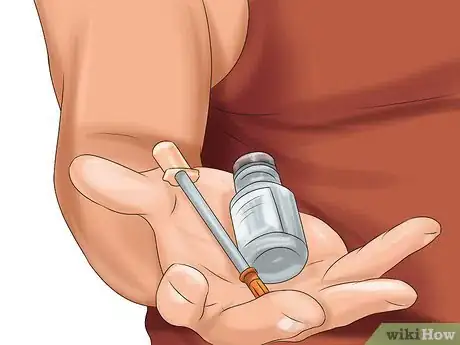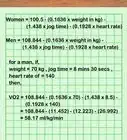This article was co-authored by Pete Cerqua and by wikiHow staff writer, Christopher M. Osborne, PhD. Pete Cerqua is a Certified Personal Trainer and Nutritionist. Pete is also a five-time best-selling author of books including "The 90-Second Fitness Solution" and "High Intensity Fitness Revolution for Women/Men" published by Simon and Schuster and Skyhorse Publishing. Pete has over 20 years of personal training and nutrition coaching experience and operates the 90-Second Fitness flagship studio in New York City.
There are 12 references cited in this article, which can be found at the bottom of the page.
This article has been viewed 18,653 times.
Do you want to go from running a 5k to a half-marathon, or bike a forty-mile trail? Do your find yourself often running out of steam when you exercise? Anyone can increase his or her athletic endurance, with the right combination of preparation and training. Be patient, be determined, and be smart about the process, and you can achieve your goal.
Steps
Preparing Your Body
-
1Adopt healthy habits. Increasing athletic endurance requires your body to be able to make more efficient use of its energy supply. A body that is not hampered by unhealthy habits that decrease efficiency will have a gentler hill to climb. Improving your overall health is beneficial in and of itself as well.[1]
- A healthy body requires sufficient rest and recovery time. Make sure you are getting enough sleep. Most adults should seek seven to nine hours per night.
- If you smoke, focus your energies on quitting first. Few activities can more easily rob you of your athletic endurance, not to mention negatively impact your health.
- Drink alcohol in moderation. While there is some evidence that moderate alcohol consumption (one drink per day for women, two drinks per day for men) may help people exercise longer and with more enjoyment, excessive alcohol consumption will only slow you down and cause endurance-sapping health problems.
-
2Eat lean proteins, colorful fruits and veggies, and smart carbs. Essentially, the same dietary guidelines that benefit everyone are advised for those seeking to improve athletic endurance. The right balance and variety of foods enables your body to efficiently produce the energy needed to fuel athletic endurance.[2] [3]
- Choose a variety of colorful fruits and vegetables — peppers, blueberries, tomatoes, etc. They offer antioxidants that combat the free radicals in your body that can hamper muscle recovery, among many other benefits. Aim for 7-10 servings per day.[4]
- Proteins supply amino acids that are used by the body to rebuild muscle tissue. Choose lean proteins like fish, poultry, low-fat yogurt, and soy products to reduce harmful saturated fat intake.[5]
- Carbohydrates are the main supplier of glycogen, which your body stores as its energy source. For more nutrients and less sugar intake, choose whole grains and unrefined carbs like oatmeal and beans.
Advertisement -
3Drink lots of water. Every part of your body requires adequate hydration in order to function efficiently, including your muscles, lungs, and cardiovascular system. Start drinking water well before you begin exercising, perhaps 16-24 ounces or 500 to 1000 ml before a lengthy workout, and continue hydrating during and after.[6]
- Drinking more water will benefit your health whether you are working out that day or not. There is some debate as to whether the old advice to drink eight, eight-ounce glasses of water per day is ideal for everyone. But, it is very difficult to drink too much water, so drink consistently through the day, before you feel thirsty.
-
4Warm up before exercising. Start slowly, and thoroughly warm up and then stretch, especially those muscle groups that will be doing most of the work.[7]
- Some recommend doing a “dynamic warm up” in order to improve performance. This can include squats, lunges, jumping jacks, and other more active forms of limbering up. Slowly ratchet up your warm up to this point, however, to reduce your risk of injury.[8]
Training Efficiently
-
1Consider consulting your doctor before beginning a training program. We all know that exercise is good for our health, and for most people a dedicated program for increasing athletic endurance is safe and healthy. However, if you meet any of the criteria below, or are unsure of your health status, it is advisable to consult your physician first. Consider contacting the doctor if:[9]
- You are or may be pregnant, are over age 35, have a family history of heart disease before age 60, live a sedentary lifestyle, or are significantly overweight.
- You have heart disease, high blood pressure or cholesterol, diabetes or pre-diabetes, lung disease or asthma, kidney disease, arthritis, or cancer (now or previously).
- You experience chest pain, rapid or irregular heartbeat, lightheadedness, excessive shortness of breath, severe leg pain or ankle swelling during exercise.
-
2Take a gradual approach.[10] As you might expect, there are no shortcuts to increasing your athletic endurance — at least in a healthy and lasting manner. It takes time, persistence, and patience. Pushing yourself too hard, too fast is more likely to result in injury as opposed to increased endurance.[11]
- If running is your focus, some experts recommend using a “low and slow” approach, which reduces your injury chances. Aim to run at about 80% of your maximum effort, and strive to increase your training time about 10% (or perhaps up to 20%) per week.
-
3Add variety to your workouts. If your goal is to be able to run a marathon, you may think that you should focus solely on running; however, utilizing a variety of workouts not only helps prevent boredom, it also helps better develop your overall health and fitness — and athletic endurance is a whole body effort. Cross-training is best used during the off-season to break plateaus and prevent overuse injuries while maintaining cardiac fitness.
- Strength training, like lifting weights, can improve your muscle efficiency and recovery, both of which aid endurance. Aim for three sessions of 30–40 minutes per week. But don’t overdo it and injure yourself.[12]
- Plyometrics involves using drills such as jumping rope, skipping, one-legged hops, and high-knee sprints to improve explosive power in the legs so that your feet can spend less time in contact with the ground while running. Increasing power and reducing friction (from ground contact) will benefit your running efficiency and, therefore, your endurance.[13]
- There are many running programs designed specifically to improve endurance. Yasso 800s, for instance, involve repeating 800 meter (3,000 ft) runs (with breaks in between) at the same minute pace as the hour goal you have for a marathon (for instance, four minutes for four hours). In the end, endurance training is an individualized process, and may require some trial-and-error to find what works best for you.
-
4Increase your short-, medium-, and long-term endurance. The human body has three energy systems to draw from based on the nature of our exertion. The short-term system (known as ATP/PC) gives you a burst of energy for about ten seconds; the medium system, glycolysis, draws the glycogen from your muscles and produces lactic acid or “muscle burn”; the long-term system is oxidative (or aerobic), utilizing oxygen intake as a steady fuel-production source.[14]
- While aerobic activity is typically what people have in mind when they want to increase endurance, improving all three systems will give you the best balance of energy production and exertion.
- Interval training helps exercise all three energy systems. It often involves running at high speed for short bursts (often 30 seconds to one minute), interspersed with cool-downs of equivalent or slightly longer periods that consist of light jogging or walking. For more detail on an interval training regimen, see How to Increase Your Running Stamina.
-
5Push back your “lactate threshold.” Athletic endurance begins to wane once you start to feel the familiar “burn” in your muscles. While this sensation isn’t actually caused by a buildup of lactic acid, as is often assumed, lactate is released along with the proton buildup that causes acidosis (and the burning sensation). Your “lactate threshold” is the point during physical exertion when the balance tips and the discomfort begins. But, with training, you can push back this threshold.[15]
- A three-part process is recommended for increasing your lactate threshold. First, slowly but steadily increase your training volume by ten to twenty percent per week.
- Second, spend roughly ten percent of your weekly training time doing “tempo runs” at the verge of your existing lactate threshold — the point where you just start feeling “the burn.” This is usually at about 50-60% of the maximum recommended heart rate for a novice, and 80-90% for an elite athlete. Consult your doctor regarding your maximum heart rate and overall fitness level.
- Third, spend another ten percent of your weekly workout schedule on interval training, perhaps by repeating four-minute intervals of high and low intensity exercises.
Gaining an Edge
-
1Listen to music. If you’re looking for a little endurance boost, skip the dangerous, illegal, or dubious options. Studies have shown that listening to music while exercising can increase your endurance by up to 15%. The benefit, it appears, boils down to an improved mood and the element of distraction.[16]
- The type of music you choose matters, though. Music at a tempo of between 120 and 140 beats per minute is most effective, so your favorite slow love songs or classical pieces may not make the cut.
-
2Load up on carbs before an endurance event. “Carbo-loading” is an endurance-boosting technique familiar to elite long-distance runners, swimmers, and bicyclists. Essentially, it involves providing your muscles with as much fuel (as glycogen) as possible in an effort to keep from running out while competing. Done correctly, it can increase glycogen amounts by 25%-100%, but is only helpful for endurance activities of at least 90 minutes duration.[17] So if you're just preparing for a tennis game, carbo-loading is unlikely to help you increase endurance.
- Starting three or four days before the target event, you increase your carbohydrate intake to about 70% of your total daily calories (up from a typical 50%). At the same time, you should ramp down your training regimen to help store fuel for the big day.
- Not all carbs are created equal, though. As is the case at any other time, you should choose whole grains and unrefined, unprocessed carbs when possible. A sample carbo-loading diet is available at http://www.mayoclinic.org/healthy-lifestyle/nutrition-and-healthy-eating/in-depth/carbohydrate-loading/art-20048518?pg=1.
-
3Consider caffeine. For the past several decades, researchers have been trying to figure out exactly why substantial caffeine intake before exercise (about 3-9 mg per kg body weight, or roughly two to six cups of coffee) increases stamina among elite athletes in lab settings. Some think it stimulates the use of stored fat for fuel, saving your glycogen reserves for later use. Regardless of why, it does seem to help with endurance over both shorter bursts (about five minutes) and athletic activities of longer duration.
- Please note, however, that athletic organizations including the IOC and NCAA have caffeine limits for competitors, and that these temporary benefits do not provide lasting benefits of increased efficiency. In the long term, you are better served by increasing your endurance through hard work, not a pot of coffee.
-
4Avoid illegal and/or dangerous performance enhancers. Beyond the fact that performance enhancers like steroids are illegal without a doctor's prescription and/or may lead to sanctions by an athletic organization with which you are affiliated, they are often simply quite dangerous to your health. The temporary benefits to endurance and performance they may offer will be far outweighed by the damage they are likely to cause.[18]
- Performance enhancers like steroids can sometimes cause heart attacks and other serious medical events. They can also stunt your growth; cause blood clotting problems; cause high cholesterol and blood pressure; create liver problems; lead to mood swings; reduce sperm production; cause nausea and abdominal pain; and damage your kidneys.
- Some known performance enhancers that are thought to increase endurance include Provigil (modafinil), GW1516 and AICAR, meldonium, Erythropoietin, and amphetamines.[19] [20] Some of these, such as Erythropoietin, are available by prescription to treat other conditions.[21]
- Talk to your doctor before beginning a performance enhancing product — including supplements which may be labeled with terms like "extreme endurance," "performance energy," "EPO-boost," etc. — even if it is legal to purchase without a prescription. It may have dangerous side effects and/or interact with medications you take.
References
- ↑ http://www.fitnessmagazine.com/workout/running/running-101-a-beginners-guide/
- ↑ http://www.muscleandfitness.com/workouts/workout-tips/10-tips-endurance-training
- ↑ http://www.mayoclinic.org/healthy-lifestyle/nutrition-and-healthy-eating/in-depth/carbohydrate-loading/art-20048518?pg=1
- ↑ http://www.hc-sc.gc.ca/fn-an/food-guide-aliment/basics-base/quantit-eng.php
- ↑ Pete Cerqua. Certified Personal Trainer & Nutritionist. Expert Interview. 14 May 2020.
- ↑ http://www.muscleandfitness.com/workouts/workout-tips/10-tips-endurance-training
- ↑ Pete Cerqua. Certified Personal Trainer & Nutritionist. Expert Interview. 14 May 2020.
- ↑ http://www.muscleandfitness.com/workouts/workout-tips/10-tips-endurance-training
- ↑ http://www.mayoclinic.org/healthy-lifestyle/fitness/in-depth/exercise/art-20047414?pg=1
- ↑ Pete Cerqua. Certified Personal Trainer & Nutritionist. Expert Interview. 14 May 2020.
- ↑ http://www.active.com/running/articles/boost-your-endurance-in-7-simple-steps
- ↑ http://www.muscleandfitness.com/workouts/workout-tips/10-tips-endurance-training
- ↑ http://www.active.com/running/articles/boost-your-endurance-in-7-simple-steps
- ↑ http://www.muscleandfitness.com/workouts/workout-tips/10-tips-endurance-training
- ↑ https://www.unm.edu/~lkravitz/Article%20folder/lactatethreshold.html
- ↑ http://www.weightlossresources.co.uk/exercise/workouts/music-increase-exercise-endurance.htm
- ↑ http://www.mayoclinic.org/healthy-lifestyle/nutrition-and-healthy-eating/in-depth/carbohydrate-loading/art-20048518?pg=1
- ↑ http://www.mayoclinic.org/healthy-lifestyle/tween-and-teen-health/in-depth/performance-enhancing-drugs/art-20046620?pg=1
- ↑ http://www.mayoclinic.org/healthy-lifestyle/fitness/in-depth/performance-enhancing-drugs/art-20046134?pg=2
- ↑ http://www.mayoclinic.org/healthy-lifestyle/fitness/in-depth/performance-enhancing-drugs/art-20046134
- ↑ http://www.mayoclinic.org/healthy-lifestyle/fitness/in-depth/performance-enhancing-drugs/art-20046134




































































